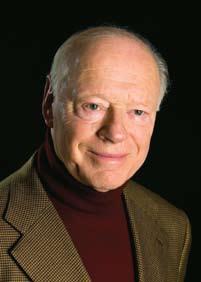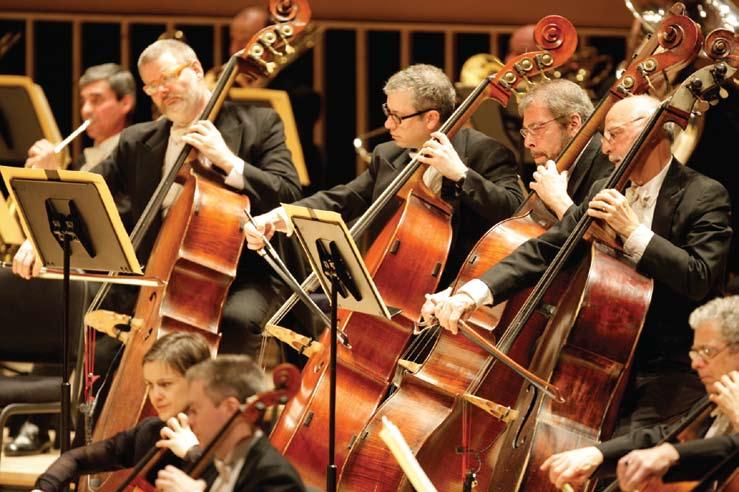

海廷克 Bernard Haitink
首席指揮
Principal Conductor
荷蘭阿姆斯特丹出生,當今音樂界首 屈一指的指揮家海廷克,縱橫世界各 地,出任指揮逾半世紀。他曾領導許 多世界著名樂團,包括在阿姆斯特丹 皇家音樂廳樂團擔任音樂總監達25 年。此外,他也曾出任德累斯頓管弦 樂團、高文花園皇家歌劇院、格蘭特 堡節日歌劇院及倫敦愛樂樂團等樂團 的音樂總監。海廷克現任阿姆斯特丹 皇家音樂廳樂團桂冠指揮和波士頓交 響樂團榮休指揮,經常為柏林愛樂樂 團、維也納愛樂樂團、巴伐利亞廣播 交響樂團、倫敦交響樂團等世界頂尖 樂隊擔任客席指揮。2006年起海廷克 擔任芝加哥交響樂團首席指揮。
2008/09年樂季,海廷克在芝加哥駐 團三周,帶領芝加哥交響樂團演出馬 勒的第六交響曲及特內奇《芝加哥遺 址》的世界首演,並和芝加哥交響樂 團合唱團合作,演出普朗克的《榮
耀》和拉威爾的《達芙妮和克洛埃》。
2008年盧塞恩復活節音樂節上,他與 歐洲室樂團合作,演出一系列貝多芬 交響樂、協奏曲和序曲。
海廷克曾經帶領芝加哥交響樂團錄製 馬勒的第三及第六交響曲,以及布魯 克納的第七交響曲。又曾與阿姆斯特 丹皇家音樂廳樂團錄製馬勒、布魯克 納和舒曼的交響樂全集,與柏林愛樂 樂團、維也納愛樂樂團及波士頓交響 樂團也合作推出過多張唱片。他最近 與倫敦交響樂團灌錄了布拉姆斯交響 樂全集和貝多芬交響樂全集。海廷克 推出的唱片還包括與皇家歌劇院、格 蘭特堡歌劇節、巴伐利亞廣播交響樂 團及德累斯頓管弦樂團合作的歌劇錄

With an international conducting career that has spanned more than five decades, Amsterdam-born Bernard Haitink is one of today’s most celebrated conductors. Appointed Principal Conductor of the Chicago Symphony Orchestra (CSO) in 2006, he has led many of the world's major orchestras, including more than 25 years at the helm of the Royal Concertgebouw as its Music Director. In addition, Haitink has previously held posts as Music Director of the Dresden Staatskapelle, Royal Opera, Covent Garden, Glyndebourne Festival Opera, and the London Philharmonic. He is Conductor Laureate of the Royal Concertgebouw Orchestra and Conductor Emeritus of the Boston Symphony Orchestra. He continues to make frequent guest appearances with the Berlin Philharmonic, Vienna Philharmonic, Bavarian Radio Orchestra, London Symphony, and other leading orchestras around the world.
Haitink’s 2008/09 season in Chicago began with a three-week residency in October and November, during which he led the CSO in concerts including Mahler's Symphony No. 6, the world premiere performances of Mark-Anthony Turnage's Chicago Remains, and both Poulenc's Gloria and Ravel’s Daphnis and Chloe with the Chicago Symphony Chorus. At the Lucerne Easter Festival 2008 he began a cycle of all of Beethoven's symphonies, concertos, and overtures with the Chamber Orchestra of Europe.
With the CSO, Haitink has recorded Mahler’s Symphony Nos. 3 and 6 and Bruckner's Symphony No. 7. He also has recorded the complete cycles of the symphonies of Mahler, Bruckner, and Schumann with the Concertgebouw and numerous recordings with the Berlin and Vienna Philharmonics as well as the Boston Symphony Orchestra. With the London Symphony, his most recent recordings are the complete Brahms and Beethoven symphonies. In addition, his discography includes many opera recordings with the Royal Opera and Glyndebourne, as well as with the Bavarian


芝加哥交響樂團的輝煌歷史可追溯至 1891年,當時芝加哥富商查爾斯. 諾曼.菲邀請著名的德國指揮家狄奧 多.湯瑪斯籌組一隊交響樂團。當時 湯瑪斯已是美國頂尖指揮家,他旅美 的目的就是為了弘揚交響樂。其後繼 任的音樂總監包括史托克、迪法、羅 津斯基、庫貝立克、萊納、蘇提爵士 及巴倫波英。2010年起,穆狄將出任 樂團第十位音樂總監。
芝加哥交響樂團與伊利諾伊高地公園 舉行的拉維尼亞音樂節結下樂緣多 年。1905年11月,芝加哥交響樂團 在拉維尼亞第二樂季舉行了首場演奏 會,從那年起直到1931年8月,樂團 在拉維尼亞作半定期的演出。1936年 8月樂團為首屆拉維尼亞音樂節揭開序 幕,此後每年夏天都擔任駐節樂團。

Awards from the National Academy of Recording Arts and Sciences.
The CSO's distinguished history began in 1891, when Chicago businessman Charles Norman Fay invited the highly respected German conductor, Theodore Thomas, to establish a symphony orchestra. Thomas was the leading conductor in America; his mission was to develop a tradition of symphonic music. Succeeding music directors include Frederick Stock, Désiré Defauw, Artur Rodzinski, Rafael Kubelík, Fritz Reiner, Sir Georg Solti, and Daniel Barenboim. Beginning in 2010, Riccardo Muti will become the Orchestra’s 10th Music Director.
The CSO has long been associated with Ravinia, in Highland Park, Illinois, having first performed in Ravinia Park's second season in November 1905 and appearing semi-regularly through August 1931. The Orchestra helped to inaugurate the first season of the Ravinia Festival in August 1936 and has been in residence at the Festival every summer since.

Wolfgang Amadeus Mozart
Symphony No. 41 in C, K 551 (Jupiter)

Wolfgang Amadeus Mozart completed the Symphony in C major on 10 August 1788. He didn’t expect it to be his last symphony and never called it Jupiter. According to an entry in the British publisher Vincent Novello’s diary, Mozart’s son Franz Xaver reported that the London impresario Johann Peter Salomon gave the work its nickname after the most powerful of the Roman gods. The title first appeared in print for a performance in Edinburgh on 20 October 1819. When Muzio Clementi’s popular piano arrangement of the score was published in 1823, the cover announced “Mozart’s celebrated Symphony, ‘The Jupiter’”, and depicted the god himself regally sitting atop billowing clouds.
This great C major Symphony was celebrated long before Clementi introduced its splendors to countless eager amateur pianists. Joseph Haydn, who also owed the existence of his last twelve symphonies to Salomon, knew the work and admired it excessively.
Salomon’s nickname probably was suggested by the majesty and nobility of the first movement, which includes the brilliant sound of trumpets and drums and features stately dotted rhythms in the opening measures (C major was the traditional key for ceremonial music in the 18th century). But the movement, cast in conventional sonata form, is also light and playful. Mozart starts the recapitulation in the wrong key (the subdominant) as an inside joke and quotes the music of a light-hearted aria he recently had written to a text presumably by Lorenzo da Ponte: “You are a bit innocent, my dear Pompeo”, a bass sings to an inexperienced lover, “Go study the ways of the world”. Like Don Giovanni, this movement is the quintessentially Mozartean mixture of the serious and the comic.
The Andante, with muted strings to counter the noonday brilliance of the opening movement, exposes the darkness that often is at the heart of Mozart’s music. This is a world of poignant contemplation, yearning and distress. It is as heart wrenching as Pamina’s great aria from The Magic Flute and even more remarkable for being in a major key. The minuet and trio are unusually rich and complicated, both musically and emotionally, for all their plain, traditional dance forms.
The finale that includes the famous fugue at the end is as celebrated as any single movement of 18th-century music. It begins innocently enough, with an innocuous do-re-fa-mi theme, and turns into a tour de force of classical counterpoint. Five themes are presented, developed and restated; then, at the end, in the great, miraculous coda, they are brought together in various combinations (sometimes upside-down) in a dazzling display of perfect counterpoint. With these two minutes of music, Mozart shifts the centre of gravity from the beginning of the symphony to the end, anticipating Beethoven, Brahms and countless other composers who owe him so much else in this field. Mozart cannot have known that this work would bring his own symphonic career to an end, but he could not have found a more spectacular and fitting way to crown his achievements, and, at the same time, to point the way to the future.

2009年2月7日(星期六)
7.2.2009 (Saturday)

馬勒 (1860-1911)
Gustav Mahler (1860-1911)
A小調第六交響曲
有活力的快板,但不太快 諧謔曲:沉重 中庸的行板 終曲:中庸的快板 ── 有活力的快板
Symphony No. 6 in A minor
Allegro energico, ma non troppo
Scherzo: Weighty
Andante moderato
Finale: Allegro moderato Allegro energico
演出長約1小時30分鐘,不設中場休息
Running time: approximately 1 hour and 30 minutes with no interval
A小調第六交響曲

「第六交響曲」是馬勒最遲登陸美國的交響曲,1947年12月才在美國首演,距作曲家 親自指揮的世界首演超過41年。芝加哥交響樂團更遲至1968年才演出馬勒第六,而馬 勒其他交響曲,包括未完成的「第十」卻早已演遍。馬勒交響曲的典型遭遇是:由作 曲家親自指揮的首演困難重重,遭觀眾和樂評誤解和唾棄,往後數十年被大樂團和名 指揮忽視;但即使如此,第六仍是最被忽視的一首。
馬勒妻子艾瑪說第六是馬勒最個人的作品,而馬勒則是第一個料到樂曲會得到什麼待 遇的人。樂曲完成後,馬勒給理查.史帕赫特寫信道:「我的第六會留下很多謎團, 只有後世那些已經吸收並徹底了解我前五首交響曲的人才能解開。」即使在馬勒生 前,第六也似乎成功無望:除了在1906及1907年由馬勒親自指揮的寥寥數次演出外, 在馬勒1911年離世前顯然再也沒有演出過。
馬勒事業上最大的悲劇不在於他默默無聞、無名無利──相反,他是樂壇名人,是 當時的名指揮家之一──而在於他認為自己真正的終生事業失敗了,落得飲恨而 終。1911年他過世時完全沒想過第六還有演出的機會,也肯定不會知道有人會欣賞他 的音樂。
馬勒差不多所有交響曲都是在暑休時動筆,第六也不例外。馬勒在沃爾特湖畔的麥爾 尼格有幢別墅;1903年6月,他與艾瑪和年幼的女兒瑪利亞到那裏度假;待到第三個 夏季,馬勒才得以在詳和氣氛裏作曲。
那個夏天,馬勒寫了第六兩個樂章。艾瑪憶述:「第一樂章草稿完成後,他自樹林走 過來,告訴我曲中有個代表我的主題:『我不知道寫得像不像,但你都得忍受。』」
身為維也納歌劇院靈魂人物的馬勒,熬過又一忙亂的樂季後,翌年夏季帶着艾瑪、瑪 利亞,還有剛出生的女兒安娜,再度前往麥爾尼格度假。這是他一生中創作最豐富的 時候:完成了第六,開始「第七」,又寫作了《亡兒之歌》最後一首。本來是舉家度 假的安寧日子,馬勒竟然寫作這種歌曲,很令艾瑪心緒不寧。她也在第六的諧謔曲看 到一團討厭的烏雲:「他在第三樂章刻畫了兩個小孩不規則的玩樂聲,在沙上搖搖欲 墜地走着走着。孩子的聲音越來越悲傷,最後在抽噎聲逐漸消失。很不祥。」
可是,最不祥的莫過於終樂章。艾瑪寫道:「他在終樂章寫自己、寫自己倒下;或 者,就像他後來自言,是他的英雄:『命運在英雄身上重重地捶了三下,最後一下把 他擊倒,像大樹一樣倒下。』那是他的話。」這首陰暗、悲哀的作品令艾瑪十分憂 慮,馬勒更一度想把此曲稱為《悲劇》交響曲,她害怕丈夫寫這樣的曲子,會葬送了 兩人最快樂的光陰。
回顧第六完成以後馬勒所經歷的種種不幸,很難不令人拿來與曲中的三下重擊相對 照。1907年,輿論壓力、紛爭、愈演愈烈的反猶太主義,迫使馬勒從維也納歌劇院的 高職上退下來;同年夏季,馬勒一家人到達麥爾尼格度假後不久,長女瑪利亞染上猩 紅熱,不出幾周就死了。馬勒還未來得及自悲傷中復原過來,就被診斷出有嚴重心臟 病──套用他自己的話,那就是最後一擊,使他像大樹一樣倒下。
不論是預言、玩命還是純粹音樂,第六也是馬勒惟一真正哀傷的作品──惟一最終沒 有得勝、曲中無名英雄最終徹底被擊倒的一首。他其他作品都不會像這首一樣堅持一 馬勒


個調性:四個樂章裏有三個以A小調寫成。雖然馬勒的交響曲以首尾調性風馬牛不相及 聞名,在這裏他似乎逃不過被陰森的A小調牽引:樂曲以低音A開始,最後一頁也以同 一個低音A完結。
奏鳴曲式的第一樂章以軍樂開始──不是「第二」、「第五」那種沉鬱的葬禮進行曲, 而是快速緊湊的進行曲──那是馬勒童年回憶中軍人的音樂。鼓聲經常出現;這裏 鼓和敲擊樂用得比其他交響曲都多。進行曲樂段結束時的音型在曲中反覆出現:輝煌 的大三和弦轉為小三和弦,同時鼓聲的節奏仿如軍校教官似的。寧靜的管樂讚美詩過 後,衝動的「艾瑪」主題猛然在小提琴馳騁,艾瑪形容這是「美妙的飛翔主題」;這個 主題每次出現都有點變化,就像艾瑪本人一樣既難捉摸又迷人。
音樂平靜下來,遠處傳來牛鈴的聲音。馬勒在樂譜上的註腳寫着:「牛鈴要奏得小心謹 慎,要栩栩如生地描繪放牧中的牛群,由遠而近,一個或多個牛鈴交替奏出,還要高 低音交錯。作曲家在此特別強調這項技術提示不容任何標題性詮釋。」不過後來馬勒確 實說過,牛鈴是「山上的靈魂離開塵世前一刻,聽到自山下遠處傳來塵世的聲音。」
馬勒原打算把〈諧謔曲〉放在恢弘的第一樂章後,把平靜的〈行板〉放在宏大的終樂章之 前。可是樂曲1906年5月在埃森首演時他卻把〈諧謔曲〉和〈行板〉的次序倒轉;但初版 樂譜卻又把〈諧謔曲〉維持在〈行板〉前,再以註解說明馬勒的疑慮。現在大多數指揮 家,包括海廷克都會把〈諧謔曲〉維持在〈行板〉前,儘管馬勒自己曾改變初衷。
馬勒之所以打算把〈諧謔曲〉和〈行板〉的次序對調,可能因為〈諧謔曲〉氣氛接近 第一樂章。〈諧謔曲〉A小調的開端和具有壓迫感的節奏,無疑跟第一樂章相像;中間 插進兩個溫柔的中段,搖搖晃晃的,彷彿安娜和瑪利亞兩個小女孩跌跌撞撞地走着。
兩個中段一個是F大調,另一個是D大調(第一樂章的呈示部和發展部就在這兩個調性 結束,實非巧合)。樂章結束前,樂團猛然傳來一聲尖叫──預告最後樂章──最後是 兩個小孩蹣跚不穩的腳步聲。
〈行板〉以降E大調寫成。根據調性系統,降E大調是與A小調關係最遠的調,而〈行 板〉雖然沾染了第一樂章的悲傷氣氛,但仍彷彿來自另一個世界似的。牛鈴自山谷傳 來,《亡兒之歌》的精神縈繞不散。
從各方面看來,第四樂章都屬於馬勒作品裏最大規模的樂章之一。馬勒巧妙地徐徐築 起這篇巨著,三個宏偉的高潮分別以一下槌聲終結。音樂變化多端,既引用了前三樂 章的素材,所用樂器又五花八門,大木槌是必然之選。
樂章氣氛凝重,先呼應諧謔曲結束時的尖叫聲──令人不安的聲響突然傳出(即使根 據馬勒的標準來說也堪稱怪異)。隨後是複雜無比的音樂(馬勒的對位法功力尤其令人 嘆為觀止),高潮樂段和聲出人意表,這時大木槌以極強力度擊下,是為第一擊。還有 兩次,經過龐大且精密的樂段後,氣氛接近狂喜的當兒,木槌再度重重擊下。到最後 只剩下苟延殘喘的聲音,卻又令人毛骨悚然地霍然一撲,再在了無生氣的A小調結束。
首演後一段時間,馬勒決定略去第三擊──就是令英雄倒下的一擊(海廷克這次也會 略去第三擊)。可是馬勒對將臨的厄運束手無策,無法阻止心臟病蠶食他的健康,以 及極速地奪去他的性命。
根據芝加哥交響樂團評註員菲力普.胡莎之樂曲介紹改編。
樂曲介紹中譯:鄭曉彤


her husband, in writing this music, had altered forever the happiest time of their life.
In reviewing the sad events that followed the completion of this symphony, it is difficult not to admit a parallel with the three blows of fate Mahler had etched in music. In 1907, bad press, controversy and rising anti-Semitism forced Mahler from his prestigious post as head of the Vienna Opera. That summer, soon after the family retreated to Maiernigg, Maria, the older daughter, fell ill with scarlet fever and died within weeks. Before Mahler could begin to recover from this shock, his serious heart condition was diagnosed—the final blow that would ultimately fell him as a tree is felled.
Whether it was prophesy, tempting fate, or simply music, the Symphony No. 6 is Mahler’s only tragic work in the truest sense—the only one that fails to rise to victory, the only one in which the unnamed hero is utterly defeated. No other work so unrelentingly asserts a single key: three of the four movements are planted in A minor, and, although Mahler is known for the way his symphonies end in keys never suggested by their openings, here he seems unable to escape the grim pull of A minor, and the final page ends with the same low A with which the first movement opens.
The work begins with military music—not the leaden funeral marches of the Second or Fifth Symphonies, but a quick, driven march—soldiers’ music remembered from his childhood. There is the recurring sound of drums; Mahler calls for a larger contingent of drums and percussion here than in any other symphony. The march ends with a sound that becomes the symphony’s motto: a brilliant major triad that turns to minor while the drums pound the drillmaster’s rhythm. After a quiet wind chorale, the impetuous “Alma” theme takes wing in the violins—a “great soaring theme”, as Alma described it—and each time it returns throughout the movement, it is slightly changed, as elusive and bewitching as Alma herself.
Later, when the music calms, we hear from the distance the sound of cowbells. Mahler added a footnote to the score suggesting that “the cowbells should be played with discretion—so as to produce a realistic impression of a grazing herd of cattle, coming from a distance, alternately singly or in groups, in sounds of high and low pitch. Special emphasis is laid on the fact that this technical remark admits of no programmatic interpretation”. Later, however, Mahler did say that the cowbells “are the last earthly sounds heard from the valley far below by the departing spirit on the mountain top”.
Mahler originally planned to follow the great sonata-form first movement with the Scherzo, placing the calm Andante before the vast finale. But at the time of the symphony’s premiere, in Essen in May 1906, he reversed the two inner movements. The first published score, however, kept the Scherzo before the Andante —though with a note about Mahler’s second thoughts—and it is this sequence that most conductors today, Bernard Haitink included, prefer, despite Mahler’s own apparent change of heart.
Mahler may have contemplated delaying the Scherzo because it is so closely related to the mood of the first movement. Certainly the opening, with its driving A minor rhythm, sounds as if it belongs to the previous music. Two gentle trios interrupt the Scherzo, both rocked by the totterings of little Anna and Maria, one in F and one in D (the keys, not coincidentally, in which the exposition and development of the first movement had come to rest). There is a great, prophetic orchestral scream—a premonition of the finale—just before the end, and then the last zigzagging of the two children.

雙簧管 Oboes
Eugene Izotov
Principal
The Nancy and Larry Fuller Chair
Michael Henoch †
Assistant Principal
Scott Hostetler
英國號 English Horn
Scott Hostetler
單簧管 Clarinets
Larry Combs
Principal
John Bruce Yeh
Assistant Principal
Gregory Smith
J. Lawrie Bloom
降E單簧管 E-Flat Clarinet
John Bruce Yeh
低音單簧管 Bass Clarinet
J. Lawrie Bloom
巴松管 Bassoons
David McGill †
Principal
William Buchman
Acting Principal
Dennis Michel
Acting Assistant Principal

圓號 Horns
Dale Clevenger
Principal
Daniel Gingrich
Associate Principal
James Smelser
David Griffin
Oto Carrillo
Susanna Drake †
小號 Trumpets
Christopher Martin
Principal
The Adolph Herseth Principal Trumpet Chair, endowed by an anonymous benefactor
Mark Ridenour
Assistant Principal
John Hagstrom
Tage Larsen
長號 Trombones
Jay Friedman
Principal
James Gilbertsen
Associate Principal
Michael Mulcahy
Charles Vernon
低音長號 Bass Trombone
Charles Vernon
大號 Tuba
Gene Pokorny
Principal
The Arnold Jacobs Principal Tuba Chair, endowed by Christine Querfeld
定音鼓 Timpani
Donald Koss
Principal
Vadim Karpinos
Assistant Principal
敲擊樂 Percussion
Cynthia Yeh
Principal
Patricia Dash
Vadim Karpinos
James Ross
鋼琴 Piano
Mary Sauer
Principal
圖書管理員 Librarians
Peter Conover
Principal
Carole Keller
Mark Swanson
樂團行政人員
Orchestra Personnel
John Deverman
Director
Anne MacQuarrie
Manager, CSO Auditions and Orchestra Personnel
舞台技師 Stage Technicians
Kelly Kerins
Stage Manager
David Hartge
James Hogan
Christopher Lewis
Patrick Reynolds
Todd Snick
Joe Tucker
* 助理團長按資歷排 Assistant concertmasters are listed by seniority.
§ 公休 On sabbatical
† 休假 On leave
沙拉及沃森.阿穆爾團長贊助席目前懸空。
The Sarah and Watson Armour Concertmaster Chair is currently unoccupied.
芝加哥交響樂團弦樂部的座位安排,採用轉換座位制度,首位及首兩位小提琴演出者後的成員名單,每兩星期轉換一 次,按英文名稱順序排列。敲擊樂手同樣按英文名稱順序排列。
The Chicago Symphony Orchestra string sections utilize revolving seating. Players behind the first desk (first two desks in the violins) change seats systematically every two weeks and are listed alphabetically. Section percussionists also are listed alphabetically.

Paul Dukas (1865-1935)

8.2.2009 (Sunday)
Fanfare preceding La Péri
Giovanni Gabrieli (ca.1554-57-1612) Canzona septimi toni
Richard Wagner (1813-1883)
Ingolf Dahl (1912-1970)
Highlights from Die Meistersinger von Nürnberg, Act 3 (arranged by Mark Ridenour)
Prelude
Quintet
Entrance of the Mastersingers
Prize Song
Music for Brass Instruments
Chorale Fantasy on Christ Lay in the Bonds of Death
Intermezzo
Fugue
Interval
Michael Tilson Thomas (1944- ) Street Song for Symphonic Brass
Morten Lauridsen (1943- ) O Magnum Mysterium
Kurt Weill (1900-1950)
Suite from The Threepenny Opera (arranged by David Purser)
Overture
Ballad of Mack-the-Knife
Instead-of Song
Ballad of the Easy Life
Polly’s Song
Tango-Ballade
Cannon Song
Threepenny Finale
Running time: approximately 1 hour and 40 minutes with one interval
杜卡的《佩里》是芭蕾舞家杜漢諾娃 委約的四套芭蕾作品之一,1912年4 月22日於巴黎夏特雷劇院首演。
故事描述年邁的波斯貴族伊斯康德 為尋求一種吃後能長生不老之花而 雲遊四海。後來他發現一個貌美 「佩里」(波斯傳說中的仙女,被貶 凡間的天使後人,須完成功德才能 回返天庭),手裏拿着長生不老之花 沉沉睡去,就去取她手上的花。佩里 驚醒過來,伊斯康德見到她,不由得 產生了愛慕之情。佩里跳起了仙女之 舞,並慢慢靠近他,直到兩張臉快要 碰到。伊斯康德把花還給了她。佩里 消失了,伊斯康德慢慢地向死亡的黑 暗裏沉落下去。杜卡在杜漢諾娃首演 前才加入了這首嘹亮的銅管作品。
Paul Dukas
Fanfare preceding La Péri

加比埃利
《八聲部七音歌曲》
加比埃利的音樂事業,都與威尼斯聖 馬可教堂光輝的音樂藝術成就相連。
加比埃利刻意避開早期文藝復興作曲 家的複曲調音樂,創作和弦作品,而 且多是舞蹈風格,這樣不但可善用老 教堂的音響效果,更突顯宗教和民間 盛事的壯麗場面,作品空前絕後。
他為合唱團及器樂演奏創作過很多作 品,由多個合唱團同時進行演唱,或 者由合唱團與器樂演奏同時演出,產 生宏亮的對唱效果。其中純器樂作品 大部份都是銅管樂器,嘹亮的長號 和小號聲,最配合教堂寬廣的中殿 和廣場那種雄偉壯麗的氣派。加比 埃利1597年的作品《神聖交響曲》, 包含14首「歌曲」,兩首奏鳴曲和45
Paul Dukas’s La Péri was one of four ballets commissioned and premiered by Natacha Trouhanova at her gala performance in the Théâtre du Châtelet in Paris on 22 April 1912.
The story of La Péri concerns an aged Persian nobleman, Iskender, who wanders the world seeking the Flower of Immortality, which he finds in the hand of a beautiful sleeping “Péri” (an imaginary fairylike being in Persian mythology represented as a descendent of the fallen angels who are excluded from paradise until their penance is accomplished). He plucks the Flower from her grasp, she awakens, and he is filled with longing for her. She performs the dance of the Peris for him, and draws nearer until their faces touch. He surrenders the Flower to her, she disappears, and Iskender is surrounded by the darkness of mortality.
Dukas’s stirring fanfare for brass was added just before Trouhanova’s premiere performance.
Giovanni Gabrieli Canzona septimi toni
For his entire career Giovanni Gabrieli was associated with the glorious musical establishment of Saint Mark’s Basilica in Venice. Eschewing the involved polyphony of earlier Renaissance composers, he wrote in a chordal, often dancelike style that not only took full advantage of the acoustical properties of the ancient basilica, but also embodied a grandeur of religious and civic pageantry that has never been surpassed. Many of his works were composed for multiple choirs of voices and/or instruments to create spacious antiphonal effects. The pieces for instruments alone were mostly for brasses, the noble sound of trombones and trumpets being especially well suited to filling the large spaces in the huge nave and the famous square that forms the church’s entrance. Gabrieli’s Sacrae Symphoniae of 1597 is a collection of fourteen canzoni, two sonatas, and forty-five motets for six to sixteen parts. The Canzona septimi toni, written in the “seventh tone” (the Mixolydian mode, based on the

勞里特森
《無限神秘》
寫於1944年的《無限神秘》是二十世 紀末經常演出和收錄在音樂專輯中的 合唱曲目之一。勞里特森寫道:「《無 限神秘》描寫基督降生於卑微的動物 和牧羊人之間,多個世紀以來,很多 作曲家從中獲得靈感。這套作品以平 靜祥和、充滿歡欣的曲調,頌讚上帝 的恩典和歌頌聖母的偉大。」

魏爾
《三毛錢歌劇》組曲 (戴維.珀澤編曲)
《三毛錢歌劇》是二十世紀音樂劇的 一個重要里程碑。作曲家魏爾和劇作 家布萊希特以蓋伊在1728年所寫的英 國諷刺劇《乞丐歌劇》作為藍本,創 作此劇。故事的主角是倫敦蘇豪區惡 名昭彰的罪犯麥克希斯,女主角寳莉 是角色中惟一的純真姑娘,她與麥克 希斯相戀,並在他的同黨和贓物見證 下,在一個馬房結婚。寳莉的母親皮 丘姆太太極力反對婚事,於是收買了 麥克希斯的前度情婦珍妮,叫她出賣 麥克希斯,向警方舉報。最後麥克希 斯被判死刑,但其後獲女皇特赦。
此劇以強而有力的序曲開始,接着是 由街頭歌手唱出麥克希斯所作所為的 〈小刀老麥〉。寳莉的雙親皮丘姆夫 婦得知女兒與麥克希斯相戀後,唱出 〈而不是之歌〉。麥克希斯所演繹的 (悠閒生活)說出他的人生哲理。麥 克希斯逃避追捕而離開倫敦,〈寳莉 之歌〉描寫寳莉得知此事後的悲傷和 無助。〈探戈-民謠〉描寫麥克希斯的 前度情婦珍妮向警察檢舉麥克希斯
Morten Lauridsen O Magnum Mysterium
O Magnum Mysterium (O great mystery), composed in 1944, is one of the most frequently performed and recorded choral works of the late 20th century. Morten Lauridsen wrote of it, “For centuries, composers have been inspired by the beautiful O Magnum mysterium text depicting the birth of the new-born King amongst the lowly animals and shepherds. This affirmation of God’s grace to the meek and the adoration of the Blessed Virgin are celebrated in my setting through a quiet song of profound inner joy”.
Kurt Weill and Bertolt Brecht based their The Threepenny Opera, one of the 20th-century’s pivotal works of music theatre, on the 1728 English satire, The Beggar’s Opera, by John Gay. The story has as its central character, Macheath, one of the London underworld’s most notorious figures. Polly, possessor of the only shred of innocence in the entire cast, falls in love with Macheath and marries him in a stable surrounded by stolen goods and her groom’s gang. Mrs Peachum, Polly’s mother, disapproves of her daughter’s marriage. She bribes Jenny, Macheath’s former mistress, to betray him to the police. In the closing scene, Macheath is condemned to death on the gallows, but is reprieved on command of the Queen.
Following the swaggering Overture is the Ballad of Mack-the-Knife, in which a street-singer tells of the deeds of Macheath. Mr and Mrs Peachum, Polly’s parents, sing the Instead-of Song after being informed that their daughter has fallen in love with Macheath. Macheath expounds his philosophy in The Ballad of the Easy Life. Polly’s Song recounts her sadness and disillusion after Macheath has fled London when threatened with arrest. The Tango-Ballade accompanies the scene in which Jenny, Macheath’s former mistress, turns him over to the police. In Cannon Song, Macheath and Sheriff Tiger Brown reminisce about their numerous scrapes in the army. The first section of the Threepenny Finale depicts the grim site of Macheath’s
Kurt Weill Suite from The Threepenny Opera (Arranged by David Purser)
